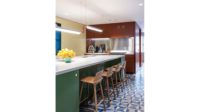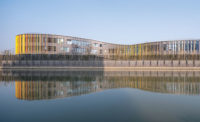The routing and capture of on-site rainwater is a key concern for students as young as kindergarteners at the Hazel Wolf K–8 E-STEM School in Seattle. Founded in 2009 and named for a 20th-century green activist and Seattle resident, it’s the city’s first environmentally focused public school. And, by design and serendipity, its own sustainable building and grounds have become fodder for teaching. “Curiosity about the surroundings is something we really encourage,” says Joe Bailey-Fogarty, who coordinates the E-STEM (environmental science-technology-engineering-and-math) program. “Observing closely, exploring and discovering how systems work is vital to the learning here.”
In an earlier location, the school had 18 acres, traversed by a stream, but that was a temporary arrangement. A 3.2-acre triangular site, about nine miles north of downtown, was available for Hazel Wolf’s permanent home. This leftover parcel was complicated by its adjacencies: an artery with banal, awkwardly skewed, low-rise apartment buildings interspersed with storefronts, and, facing the other edges, mostly neighborhoods with single-family houses.
Additional Content:
Jump to credits & specifications
NAC Architecture’s Seattle office designed the new $39 million, 680-student facility, recognizing not only Hazel Wolf’s pedagogical vision, but also the importance of resolving the site’s ambiguous in-between condition. “The architecture needed to generate a real dialogue with its diverse adjacencies,” says NAC design principal Boris Srdar. Other priorities also emerged. The school’s founding principal, Debbie Nelsen, recalls asking for “a feeling, throughout, of being outdoors in nature, with plenty of sensory interest and many different types of experiences. We had to maximize learning opportunities on this tight site.”
NAC responded with a clean-lined, 83,000-square-foot building, clad in corrugated and flat steel plates—some painted white—accented with orange, prefinished aluminum panels, and dark, split-face concrete masonry units. Shading fins and brows punctuate the south and east elevations, and some of the window groupings have a lively syncopated rhythm. Addressing the character of each adjoining piece of urban/suburban fabric, the massing was articulated as three main volumes: along the traffic artery, a long, low-slung “buffer” form houses such communal spaces as the gym and commons/cafeteria/auditorium; near a residential enclave is a three-story classroom structure; and connecting the two volumes is one containing the art room and library. While the classroom structure stands in a park-like setting, pulled back from the abutting single-family homes, the buffer wing holds its street edge, giving it definition.
But the centerpiece of the campus, framed by its built forms, is a large, protected courtyard with a 23-foot-wide, one-story-high ramp, rising like a hillside over the administration offices efficiently tucked beneath it. This dynamically “topographic” ground plane descends from fully accessible planted roofs down to a rain garden, thick with native vegetation. The route of stormwater is made visible as it flows from the rooftops down vertical conduits, through a grate-covered “mini-creek” to the water garden. There, it percolates through stones and sand into the ground. In the year since the school first opened, several students have chosen to analyze this process—and almost everyone here watches downpours with rapt attention.
The ramp, covered in resilient playground surfacing, “has many uses, and we’re still discovering more,” says Nelsen. “People congregate on it, lunch on it, run on it, and it’s become a great amenity for stress relief, especially for kids with ADD.” The long, continuous paths and spatial fluidity reflect Hazel Wolf’s educational philosophy, which prizes spontaneous, off-the-cuff teaching, alongside more formal approaches. Distinctions between work and play, indoors and out, and among certain disciplines tend to dematerialize, turning the site’s compactness—and necessary overlap of programmatic functions—into opportunity. “The blurring of lines lets the whole place become a lab for learning and experimentation,” says Srdar. “Whereas, with compartmentalization, serendipity gets lost.”
The site’s meandering routes enfold botanical and butterfly gardens and calming “sit spots” for observing or drawing. “Our previous home had natural places kids gravitated to,” says Nelsen. “We asked NAC to replicate that kind of experience.” Near the periphery, some of these areas are open to locals, stitching together school and neighborhood, and giving back to a community that supported a bond to create Hazel Wolf’s new home.
Connections to nature continue into the building, with big windows and a living wall just inside the main entrance, announcing the school’s identity. With such indoor-out qualities, “a lot of spontaneous learning happens here pretty seamlessly,” says E-STEM coordinator Bailey-Fogarty. “We just step outside to demonstrate. Or in urban ecology class, we send everyone out to look for roots, shoots, spiders, and worms. The students live the environment they’re studying—it’s all integral—and their questions become part of the process.”
Given the school’s belief in the value of seeing what’s going on all around, says Srdar, “we gave a lot of attention to sight lines and circulation.” Interior pods, or breakout spaces, punctuate the classroom clusters, offering informal areas for group or individual work. Decks extend from the library and science labs, allowing experiments to happen outside. From the building’s core, views down concrete-paved corridors reveal all four exposures. And the central stairwell includes a three-story window and an adjacent wall with exposed seismic bracing, set against a mural of the project’s handwritten structural calculations.
Recently, after a sixth-grade team presented models for natural water filtration, one pupil commented: “I don’t know any other school where you’d find a geothermal heating/cooling system [which Hazel Wolf has], a rain garden, and a living wall, but it’s all here—and we get to learn about it.”
In the near future, Hazel Wolf will get solar roof panels. “And you can be sure,” says Nelsen, “that learning opportunity won’t be missed.”
CreditsArchitect: NAC Architecture, 2025 First Avenue Suite 300, Seattle, Washington 98121, 206-441-4522, www.nacarchitecture.com
Personnel in architect's firm who should receive special credit: Kevin Flanagan, AIA, Principal in Charge, Matt Rumbaugh, AIA, Project Manager, Boris Srdar, FAIA, Design Principal, David Shaffer, AIA, Project Architect, Brian Love, AIA, Construction Manager, Teresa Alvarado, Project Designer, Sarah Finis, Interior Designer, Malcolm Jollie, AIA, Design Advisor]
Interior designer: NAC Architecture
Engineers Civil Engineer: Coughlin Porter Lundeen Structural Engineer: Coughlin Porter Lundeen Mechanical Engineer: Hargis Engineers Electrical Engineer: Travis, Fitzmaurice & Associates]
Consultants Landscape Architect: Murase Associates Construction Manager: Heery International]
General contractor: Lydig Construction
Photographer: Benjamin Benschneider Photography; NAC Architecture; Joe Bailey-Fogarty; Skytech Aerial Photo |
SpecificationsExterior Cladding Masonry: Basalite Concrete Products Formed metal panels: Morin Corporation Plate metal panels: Northclad Moisture barrier: Henry Company Precast concrete: Northwest Precast
Roofing SBS Roofing System: Soprema Vegetated Roofing System: American Hydrotech, Inc.
Windows Metal frame: EFCO Corporation Curtain wall and storefront: EFCO Corporation Horizontal sunshades: EFCO Corporation Vertical sunshades: Construction Specialties, Inc.
Glazing Glass: Guardian Glass Skylights: Major Industries Polycarbonate panels: CPI Daylighting
Doors Entrances: EFCO Corporation Metal doors: Curries Wood doors: VT Industries, Inc. Fire-control doors: Won-Door Corporation Security grilles and roll up doors: Cookson
Hardware Locksets: Stanley Security Closers: Stanley Security Exit devices: Stanley Security
Interior Finishes Acoustical panel ceilings: Armstrong Ceiling Solutions Linear metal ceilings: Hunter Douglas Linear wood ceilings: ACGI, Inc. Suspension grid: Armstrong Ceiling Solutions Operable partitions: Advanced Equipment Corporation Cabinetwork and custom woodwork: Genothen Paints and stains: PPG Architectural Coatings Wall coverings: Forbo, Tri-Kes Acoustical paneling: Snap-Tex Plastic laminate: Panolam Solid surfacing: Corian Floor and wall tile: Daltile Resilient flooring: Armstrong Carpet: Tandus Resin panels: 3-Form
Furnishings Office furniture: First Office Reception furniture: Global Chairs: VS, Academia Tables: Shuttle Furniture, Herman Miller Upholstery: Momentum
Lighting Interior ambient lighting: Architectural Lighting Works, Visa Lighting Downlights: LiteControl, Pathway Lighting Products Exterior: Kim Lighting, Cree Lighting controls: Wattstopper
Conveyance Elevators: ThyssenKrupp
Plumbing Sinks: Just Manufacturing Faucets: Chicago Faucets, Moen Fountains: Halsey Taylor Multi-station sinks: Bradley Lavatory: American Standard Toilets: American Standard Urinals: American Standard
Energy Energy management and building automation system: Siemens Photovoltaic system: Hyundai Ground source heat pump: Geo Loop Tec
Other unique products that contribute to sustainability: Vegetated wall: GSky Plant Systems, Inc.
Add any additional building components or special equipment that made a significant contribution to this project: Rubber safety surfacing: Surface America Inc. |















Post a comment to this article
Report Abusive Comment